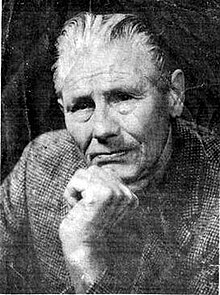René Richard
| René Richard | |
|---|---|
 |
|
| Born |
René Jeanrichard 1 December 1895 La Chaux-de-Fonds, Switzerland |
| Died | 31 March 1982 (aged 86) Baie-Saint-Paul, Quebec, Canada |
| Nationality | Swiss, Canadian |
| Occupation | Painter |
| Known for | Landscapes |
René Richard (1 December 1895 – 31 March 1982) was Swiss-born Canadian painter known for his semi-abstract landscapes of the Canadian wilderness and of the country around Baie-Saint-Paul in Quebec.
René Jeanrichard (later shortened to René Richard) was born on 1 December 1895 in La Chaux-de-Fonds, Switzerland. His father engraved pocket watches. His mother's family were artists. He had two brothers and four sisters. At the age of eleven René began to work in the watch factory after school. Due to financial difficulties, the family decided to emigrate to Canada, and landed in Quebec City in 1909. At first they stayed in Montreal. René Richard went on to Edmonton, Alberta, in 1910 with his father and brothers, and then to Cold Lake, Alberta, where they began to work the land. Richard's mother and sisters joined them later.
Conditions on the prairies in the early days were brutally demanding, and after some time Richard's father gave up farming. Instead he opened a general store. René Richard helped his father in the store as a teenager, and made trips into the bush to trap furs. René was attracted by the lifestyle of the nomadic First Nations people. From 1913 to 1926, travelling by canoe or by snowshoe, Richard traveled widely in northern Alberta, Saskatchewan, Manitoba and the Northwest Territories. He voyaged down the Mackenzie River to the Beaufort Sea, and lived for a while with the Inuvialuit. On these expeditions he would make sketches of the scenery. Richard studied drawing and painting in Edmonton, Alberta, in 1926.
Richard spent 1927–30 in Paris, where he studied at the Académie de la Grande Chaumière and the Académie Colarossi. While in Paris he met Clarence Gagnon and James Wilson Morrice. Gagnon encouraged him to devote himself to art. After returning to Alberta in 1930, Richard resumed his former career as a trapper. He made hundreds of sketches during his long wilderness journeys. He would depict landscapes and the camps of prospectors and trappers. This was an intensely productive period, when his unique style began to emerge. With little money, often he would draw on butcher's paper cut into sheets.
...
Wikipedia
